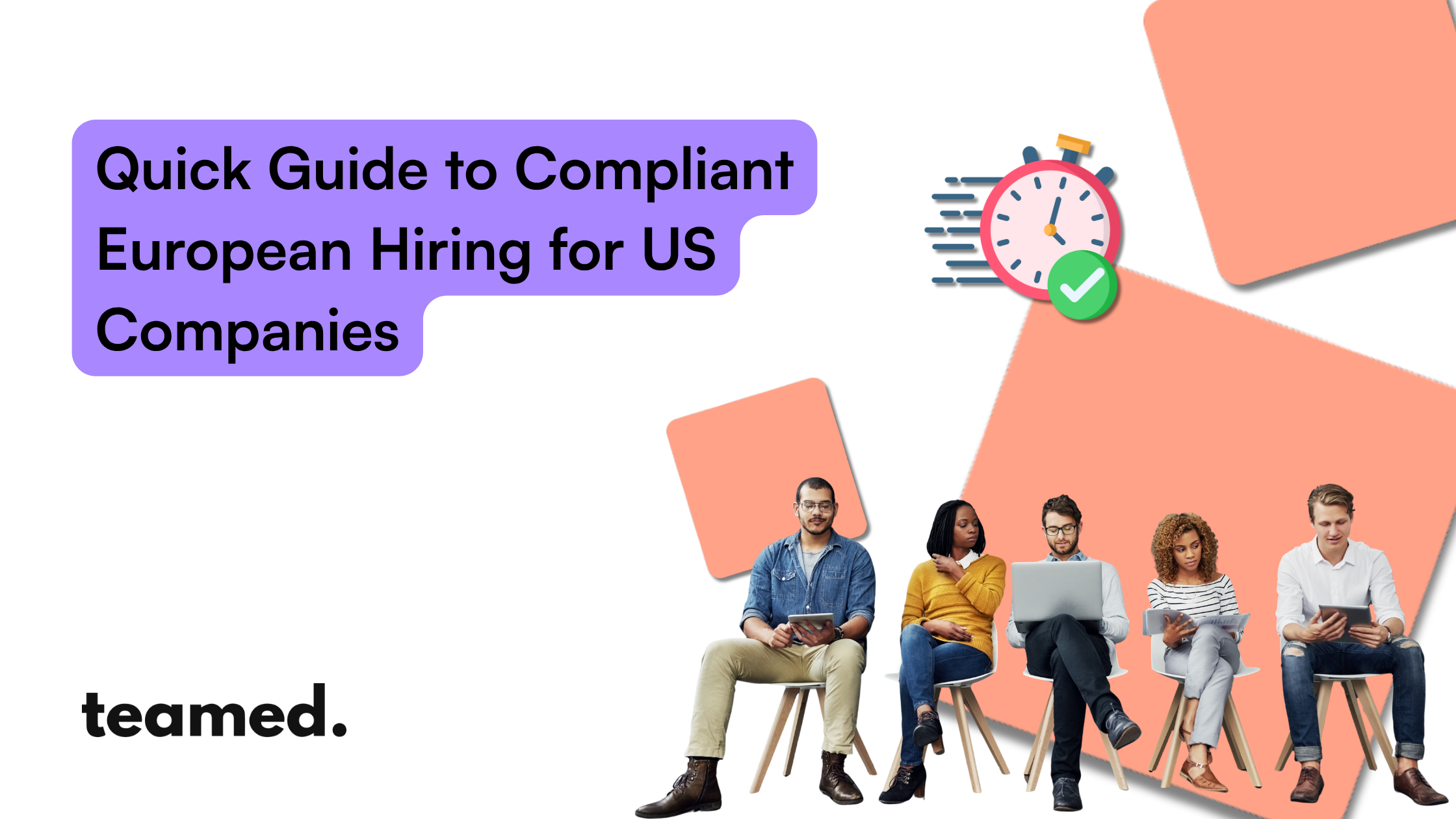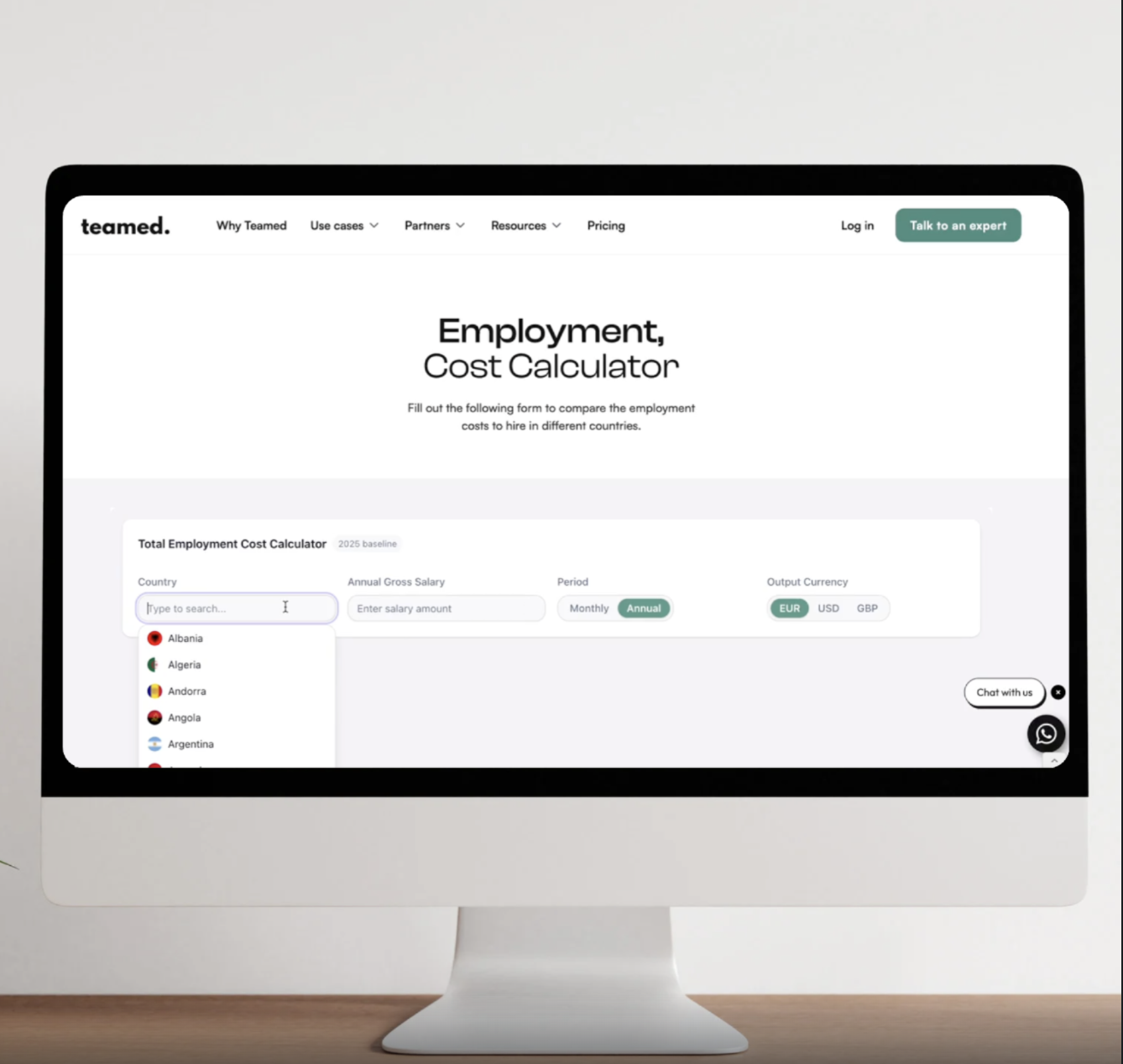Hiring in Europe means navigating 27 different employment law systems, each with its own social security deadlines, collective bargaining requirements, and misclassification penalties that can cost you years of back-pay and regulatory fines. US companies expanding across the Atlantic face a choice: spend months establishing local entities in each country, or partner with an Employer of Record who already has the legal infrastructure in place.
Insert infographic showing the complexity of European employment law across 27 countries with key compliance requirements highlighted
This guide covers the compliance rules shared across Europe, the country-specific traps that catch unprepared companies, and the three hiring models available—with clear decision criteria for when each makes sense for mid-market firms in defence, pharma, and financial services.
Key Takeaways:
- An Employer of Record (EOR) enables compliant European hiring in 24 hours without establishing local entities, handling contracts, payroll, and tax obligations on your behalf.
- European employment law varies dramatically by country—probation periods, notice requirements, and collective bargaining agreements create compliance traps for unprepared US companies.
- Misclassifying employees as contractors carries severe financial penalties across Europe, with regulators actively scrutinising working arrangements.
- Total employment costs in Europe include substantial employer contributions—typically 20-40% above gross salary—for social security, pensions, and statutory benefits.
Advantages of hiring in Europe for US firms
Hiring in Europe through an EOR gives US companies immediate access to skilled talent without the months-long process of entity formation. You get compliant employment relationships managed by local experts who handle contracts, payroll, and regulatory filings while you retain full operational control.
Europe offers deep talent pools in specialised sectors. Poland has cybersecurity engineers, Switzerland has pharmaceutical researchers, Ireland has financial analysts. Salary expectations often sit 20-30% below comparable US roles, particularly for mid-level positions, though senior leadership compensation increasingly mirrors US rates in competitive markets like London and Amsterdam.
Add chart comparing salary ranges between US and European markets across key sectors
For East Coast operations, European time zones create 3-5 hours of daily overlap with UK and Western European teams. This synchronous working window supports real-time collaboration on projects requiring immediate feedback, unlike Asia-Pacific hiring where overlap shrinks to an hour or disappears entirely.
Defence contractors expanding into European markets face mandatory local presence requirements for certain projects. An EOR satisfies these conditions without the capital expenditure and administrative burden of subsidiary formation, enabling you to bid on contracts while your legal team evaluates long-term entity strategy.
Core compliance rules shared across Europe
GDPR governs how you collect, store, and process employee data across all EU member states and the UK. Employee monitoring software, background checks, and performance tracking create data protection obligations. You'll document lawful bases for processing, implement privacy-by-design systems, and appoint data protection contacts when your European headcount reaches certain thresholds.
The Working Time Directive limits employees to 48 hours per week averaged over a reference period, mandates 11 consecutive hours of daily rest, and requires one full day off per week. While employees can opt out of the 48-hour limit in some countries, others like France prohibit waivers entirely.
Employer social security contributions fund healthcare, unemployment insurance, and state pensions. Rates vary—Germany charges roughly 20% of gross salary, France averages 45% of gross salary, while Ireland sits near 11%—but these aren't optional extras. They're statutory obligations calculated and remitted monthly, with penalties for late or incorrect payments.
Country-specific compliance traps to watch
Social security registration deadlines
Germany requires social security registration before an employee's first day of work. Miss this deadline, and you face immediate fines plus retroactive contribution demands. France allows slightly more flexibility but still expects registration within eight days of hire, while Spain mandates registration before the employment relationship begins.
These deadlines aren't administrative suggestions—they're legal requirements with enforcement teeth. Tax authorities cross-reference employment contracts with social security databases, and gaps trigger audits.
Collective bargaining agreements
The Netherlands and Nordic countries operate sectoral collective bargaining systems where industry-wide agreements override individual employment contracts. If you hire a software engineer in the Netherlands, the relevant ICT collective agreement may dictate minimum salaries, annual leave entitlements, and pension contributions regardless of what you've negotiated directly.
Collective agreements aren't published in convenient English translations on government websites. You'll need local legal expertise to identify applicable agreements and structure compliant employment terms. EOR providers maintain this knowledge as core competency, updating contract templates when agreements change.
Maximum probation periods
The UK allows six-month probation periods for most roles, giving employers extended evaluation windows before full unfair dismissal protections apply. Germany caps probation at six months but only for permanent contracts, while France limits probation to two months for non-managerial staff and four months for managers.
Exceed these limits, and your "probationary" employee gains full employment protections from day one. Termination becomes substantially more complex and expensive, particularly in countries like Italy where dismissal procedures involve lengthy notice periods and potential tribunal proceedings.
Hiring models and when to use them
1. Independent contractor
Contractors work independently on specific projects with defined deliverables and timelines. They control how they complete work, supply their own equipment, and typically serve multiple clients simultaneously.
European regulators scrutinise contractor relationships far more aggressively than US authorities. Spain's "Rider Law" presumes employment status for platform workers, France applies a 13-point test examining economic dependence, while IR35 in the UK looks through contractual labels to assess actual working arrangements.
Misclassification triggers back-payment of employer social security contributions, income tax, holiday pay, and pension contributions—often spanning multiple years. Financial services firms face additional regulatory scrutiny, as contractors performing controlled functions may invalidate regulatory approvals.
2. Employer of record
An EOR becomes the legal employer of your European staff, handling employment contracts, payroll processing, tax withholding, benefits administration, and regulatory compliance. You retain full operational control—setting work schedules, assigning projects, managing performance, while the EOR manages the legal and administrative employment relationship.
This model works particularly well for defence and pharmaceutical companies entering European markets where regulatory requirements demand immediate compliance certainty. You can onboard critical hires within 24 hours, satisfying contract obligations or regulatory deadlines without the distraction of entity formation.
Teamed's EOR service covers 180 countries with built-in AI Agents automating 70% of payroll and HR tasks. Our experts handle complex cases, works councils, collective agreements, regulatory edge cases, that automated systems can't navigate, giving you the speed of technology with the certainty of human expertise.
3. Local entity setup
Establishing a subsidiary or branch gives you complete control over employment relationships, enables direct client contracting, and signals long-term market commitment. You'll need local directors, registered office addresses, and compliance with corporate governance requirements specific to each jurisdiction.
Germany requires €25,000 minimum share capital for a GmbH, plus notarised articles of association and commercial register fees. France demands similar capitalisation for an SARL, while Ireland's limited company requires just €1 in share capital but involves more extensive ongoing compliance reporting.
Entity formation makes sense when you're hiring 50+ employees in a single country, need direct contractual relationships with government clients, or plan decade-long market presence. Until then, EOR services deliver faster time-to-market with substantially lower financial risk.
Step-by-step hiring in 24 hours with an EOR
Add process flow diagram showing the four key steps from offer letter to productive employee
1. Issue a localised offer letter
Your offer letter must comply with local employment law—specifying salary in euros or pounds, detailing statutory benefits, and including mandatory clauses around notice periods, probation terms, and dispute resolution. Generic US offer letters omit required disclosures and create enforceability issues.
EOR providers maintain country-specific templates updated for legislative changes. You provide role details, salary, and start date; the EOR generates a compliant offer incorporating all statutory requirements and local market conventions.
2. Complete background and right-to-work checks
EU and UK citizens have automatic right to work across their respective jurisdictions, but third-country nationals require work permits and visa sponsorship. Background checks vary by country—some permit criminal record checks only for specific roles, others prohibit them entirely, while certain sectors like finance mandate regulatory screening.
An EOR manages checks through established local processes, understanding what's legally permissible and what crosses into discrimination. For defence sector hiring requiring security clearances, the EOR coordinates with national security authorities while maintaining employment relationships during lengthy vetting procedures.
3. Sign digital employment contract
Electronic signatures carry full legal validity across Europe under eIDAS regulations, enabling same-day contract execution. The employment contract incorporates all statutory terms, working hours, holiday entitlement, notice periods, pension contributions—plus role-specific provisions around confidentiality, intellectual property, and garden leave.
Teamed's platform generates compliant contracts in local languages with English translations, ensuring both parties understand obligations. Contracts reflect current collective bargaining agreements where applicable, eliminating the risk of inadvertently offering below-minimum terms.
4. Onboard to payroll and benefits
Social security registration, pension enrolment, and health insurance activation happen simultaneously with contract signing. The EOR submits registration paperwork to relevant authorities, establishes payroll records, and configures benefit deductions according to statutory requirements.
Your new hire receives login credentials for self-service portals where they'll access payslips, update personal information, and submit holiday requests. IT equipment ships to their home address, and they're productive from day one—no waiting for entity formation, no gaps in insurance coverage, no compliance uncertainty.
"We needed to convert our top contractors to employees quickly when we secured a defence contract requiring employment status. The transition was seamless—Teamed handled all the paperwork, and our contractors became employees within 48 hours without any disruption to ongoing projects." — HR Director, Defence Technology Company
Switching contractors to employees without re-onboarding
Contractor-to-employee conversions happen frequently when project work becomes permanent, when regulatory requirements change, or when misclassification risk becomes apparent. Traditional approaches require terminating the contractor relationship, establishing employment infrastructure, and re-onboarding the same person under new terms—creating gaps in service delivery.
Teamed's unified platform manages contractors and employees in the same system. When you convert a contractor to employee status, we generate new employment contracts, activate payroll and benefits, and handle social security registration while maintaining the individual's existing system access, equipment, and project assignments.
The contractor experiences seamless transition—their work continues uninterrupted, they gain employment protections and benefits, and you eliminate misclassification risk without operational disruption. For pharmaceutical companies managing clinical trial teams or financial services firms bringing contractors in-house to satisfy regulatory requirements, this continuity matters enormously.
Payroll, benefits and total cost in euros
European employment costs extend well beyond gross salary. Employer social security contributions, statutory pension contributions, and mandatory insurance create total employment costs 20-40% above the salary figure you've negotiated with candidates.
Go beyond the salary. Our employment calculator reveals the true cost of a new hire, including taxes, benefits, and other on-costs, so you can budget with complete confidence.








